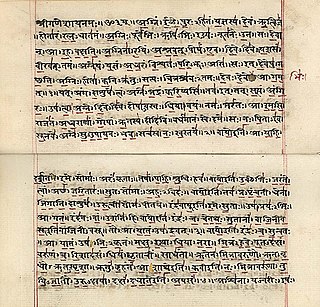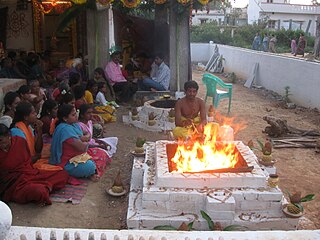 W
WThe Vedas are a large body of religious texts originating in ancient India. Composed in Vedic Sanskrit, the texts constitute the oldest layer of Sanskrit literature and the oldest scriptures of Hinduism.
 W
WThe historical Vedic religion, and subsequent Brahmanism, constituted the religious ideas and practices among some of the Indo-Aryan peoples of northwest India and the western Ganges plain of ancient India during the Vedic period. These ideas and practices are found in the Vedic texts.
 W
WThe Mahamrityunjaya Mantra, also known as the Rudra Mantra or Tryambakam Mantra, is a verse (sūkta) of the Rigveda. The sūkta is addressed to Tryambaka, "The Three-eyed One", an epithet of Rudra who is identified with Shiva in Shaivism. The verse also recurs in the Yajurveda.
 W
WPrānapada is a necessary special lagna calculated from the position of the Sun at sunrise; the Sun is the giver of life and Prānapada indicates the life energy.
 W
WPreṣya yoga is a planetary combination in Hindu astrology. A person born with preshya yoga is poor, unhappy and uneducated. He hears harsh words from others and works in slavery throughout his life.
 W
WThe Samaveda, is the Veda of melodies and chants. It is an ancient Vedic Sanskrit text, and part of the scriptures of Hinduism. One of the four Vedas, it is a liturgical text which consists of 1,549 verses. All but 75 verses have been taken from the Rigveda. Three recensions of the Samaveda have survived, and variant manuscripts of the Veda have been found in various parts of India.
 W
WSanskrit literature refers to texts composed in Sanskrit language since the 2nd-millennium BCE. Many of the prominent texts are associated with Indian religions, i.e., Hinduism, Buddhism, and Jainism, and were composed in ancient India. However, others were composed central, East or Southeast Asia and the canon includes works covering secular sciences and the arts. Early works of Sanskrit literature were transmitted through an oral tradition for centuries before they were written down in manuscript form.
 W
WSvādhyāya is a Sanskrit term which means self-study and especially the recitation of the Vedas and other sacred texts. It is also a broader concept with several meanings. In various schools of Hinduism, Svadhyaya is a Niyama connoting introspection and "study of self".
 W
WShri Timli Sanskrit Pathshala, established in 1882, is the first Sanskrit school in Garhwal Himalaya that was recognized and funded by United Provinces from 1911 to 1915 and offered high school completion programs in Sanskrit to hundreds of students. In 1952 Shri Timli Sanskrit Pathshala introduced an English as a Second Language program to meet the needs of the students.
 W
WVedi is the term for "sacrificial altar" in the Vedic religion. Such altars were an elevated outdoor enclosure, generally strewed with Kusha grass, and having receptacles for the sacrificial fire; it was of various shapes, but usually narrow in the middle.
 W
WThe Yajurveda is the Veda primarily of prose mantras for worship rituals. An ancient Vedic Sanskrit text, it is a compilation of ritual-offering formulas that were said by a priest while an individual performed ritual actions such as those before the yajna fire. Yajurveda is one of the four Vedas, and one of the scriptures of Hinduism. The exact century of Yajurveda's composition is unknown, and estimated by Witzel to be between 1200 to 800 BCE, contemporaneous with Samaveda and Atharvaveda.